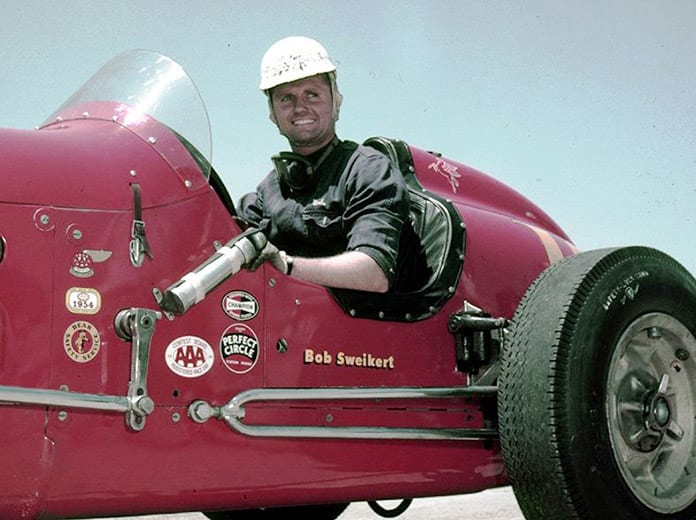The tragic death of Bill Vukovich during the 1955 Indianapolis 500 cast a shadow over the legacy of race winner Bob Sweikert.
That’s unfortunate because Sweikert was one of the most naturally talented drivers this country ever produced. Versatile, he won in midgets, sprint cars and championship cars.
Born in Los Angeles on May 20, 1926, his parents divorced before his birth. His mother remarried and in 1942 the family moved to Hayward, Calif. While in Hayward High, Sweikert wanted nothing more than to become a crooner like Frank Sinatra and took voice lessons toward that end.
Then, he discovered cars.
With savings from working part time at a Ford dealership, he bought an old Ford coupe. With it, he regularly beat all comers in street races, including a racer with whom he often crossed paths, Ed Elisian.
Out of high school, Sweikert joined the Army Air Corp. However, injuries from a training accident saw him discharged as World War II was winding down. He returned to Hayward and opened a repair shop in his parents’ garage, Sweikert Automotive.
Still fascinated with fast cars, Sweikert turned to the race track with a roadster he built. In his first race on Memorial Day 1947, he finished second at Oakland Speedway.
Midget racing was at the height of its popularity and Sweikert was in the middle of the fray, capturing the BCRA Indoor Championship in 1949.
That same year Sweikert strapped into Karl Orr’s sprint car, running a series of races at Oakland Speedway. He so impressed AAA California Zone Supervisor Gordon Betz that Betz touted him as ready for the prestigious AAA sprint car circuit and possibly Indianapolis. He scribbled across Sweikert’s driver certification, “The greatest 500 prospect from California since Freddie Agabashian.”
In 1950, Sweikert lived up to Betz’s glowing endorsement on the Midwest’s infamous high banks, a trio of blindingly fast tracks — Dayton, Winchester and Salem — considered too dangerous by many. “You don’t go to the banks, do you?” asked a reporter of tough Jimmy Bryan. “Not even on weekdays,” Bryan responded.
Sweikert thrived on them and that prowess earned him a shot at Indianapolis after barely two months in the Midwest.
The car wasn’t much. It scarcely got him through his rookie test. His 1951 ride wasn’t much better. He qualified but was bumped. In 1952, he made the field, but his race was short-lived.
With that, his career exploded. He won routinely in sprint cars. In 1953, he made Indianapolis with a top-notch team and car, the Clint Brawner-wrenched Dean Van Lines Special. In September, he won what’s still considered one of the most thrilling championship races — the first Hoosier Hundred, with the four top finishers flashing beneath the checkered flag in a photo finish.
With his success, Sweikert gained a reputation for being cocky and self-centered. Johnny Boyd, who knew him well, disagreed.
“Sweikert and A.J. Foyt were so much alike, it’s unbelievable,” insisted Boyd. “Sweikert lived, drank, ate and slept racing. He focused on racing 24 hours a day. Sweikert was good and he knew it. He was self-confident, not cocky. To me, a guy who is good has a certain carriage that conveys he’s good. Sweikert had it.”
Sweikert landed with the John Zink team and young mechanic/builder A.J. Watson in 1955. But only days before the 500, Watson got an emergency call to return to California. His pregnant wife had lost their baby.
Missing their crew chief could’ve proved disastrous for some teams. However, Sweikert led the crew in readying the car and rebuilt the Offy engine himself. It never missed a beat during his dramatic 500 win.
Along with his Indianapolis victory, Sweikert won the 1955 national championship, as well as the AAA Midwest Sprint Car Championship. He remains the only driver in history to accomplish that impressive triumvirate.
1956 loomed even brighter for the handsome 30-year-old.
But a June 17 sprint car race at Salem ended it all. Sweikert’s car brushed a chunk of metal extending from the wall and flipped violently out of the track. Sweikert died instantly.
